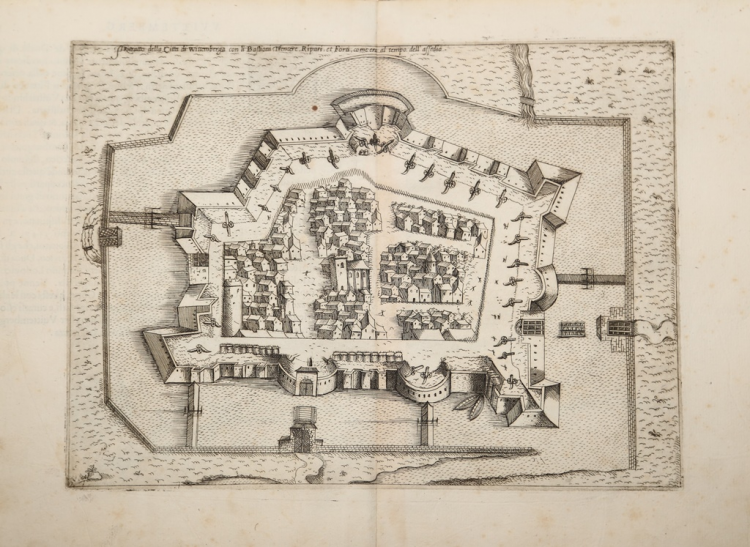



| Reference: | MS7259 |
| Author | Paolo FORLANI |
| Year: | 1567 ca. |
| Zone: | Wittenberg |
| Printed: | Venice |
| Measures: | 284 x 211 mm |


| Reference: | MS7259 |
| Author | Paolo FORLANI |
| Year: | 1567 ca. |
| Zone: | Wittenberg |
| Printed: | Venice |
| Measures: | 284 x 211 mm |
Unsigned map showing Wittenberg, ascribed to Paolo Folrani.
The map was first published in the incredible rare Paolo Forlani’s town book "“Il primo libro delle citta, et fortezze principali del mondo", published in 1567 with a partnership of Domenico Zenoi.
The plates then comes in the hand of the publisher Bolognino Zaltieri and published in the De’ disegni delle più illustri città e fortezze del mondo", by Giulio Ballino, in 1569.
Giulio Ballino was a Venetian lawyer, a friend of the Manuzio family, really fond of classical studies.
His work is the first attempt, in Italy, to realize an atlas/text of the main fortresses and cities in the world. Unlike his predecessors, from whom he copied the iconography, Ballino wanted to realize a complex work, with text and an index, so that the reader could know immediately how many works were inside the book. Following Du Pinet’s Plantz, Pourtraitz et descriptions de plusieurs ville set forteresses.. Ballino’s work is, with all probability, just the first part of an ambitious, bigger project. May be he wanted to publish a Latin edition, hoping to give his book great fame along Europe, but he had to change his mind when Georg Braun & Fransz Hogenberg published their Civitates Orbis Terrarum, which was then the first book to describe urban iconography.
Ballino’s plates have been issued between 1566 and 1568; according to Albert Ganado (1993), 32 of these happen to be reprints of Forlani & Zenoi’s branches, already published for the first time in Il primo libro delle città, et fortezze principali del mondo (1567); the plates of these engravings have been afterwards modified. Some of them have been published in Bertelli’s Disegni di alcune più illustri città di fortezze del mondo con aggiunte di alcune isole principali, (1568).
Some examples of this rare work bear an allegorical title page, engraved by the Venetian artist Nicolò Nelli, a popular engraver of the XVI century; other examples bear a blank title page. Both versions have been printed by Zaltieri in 1569. It is quite hard to say which is the first version and which the last one, for the only difference is on the text on verso, with bigger letters in one case.
Another difference is that some of the maps in one version have numbers on verso. We might say that those examples without numbers have been printed first, but the analysis of the engravings doesn’t support this theory.
The engravings listed hereby come from a defective edition; for preciseness of information, we must add that the authorship of every work has been given to the artist that realized it, even if all of them come from Ballino’s collection.
Copperplate, full wide margins, in excellent condition. Rare.
Paolo FORLANI (Attivo a Venezia seconda metà del XVI secolo)
|
Paolo Forlani, a native of Verona, opened his own chalcographic workshop in Venice, Al segno del pozzo, in 1560, as reflected in some of his works. From 1566 he was active in Merzaria al segno della colonna and from 1569 in Merzaria al segno della nave. Forlani had business relationships with the major publishers of cartographic material of the time, among them Antonio Lafreri, the Bertelli family, and others. In addition to being a talented engraver, he was also quick to execute, a quality that enabled him to work for different publishers at the same time, and to execute a large amount of work. Woodward attributes about one hundred works to Forlani, most of which, however, are unsigned. Between 1560 and 1567, Forlani collaborated with Ferrando Bertelli, for whom he engraved about ten copperplates, with Camocio, Bolognino Zaltieri, and with Claudio Duchetti, for whom he engraved some maps. For his professional activity, however, the collaboration with Giacomo Gastaldi, for whom he engraved thirteen maps, was very important and valuable. In 1567 Forlani published and traded his work Il primo libro delle città et fortezze principali del mondo, whose branches later passed to Bolognino Zaltieri. It is likely that Forlani died during the plague that spread through Venice from 1575.
|
Paolo FORLANI (Attivo a Venezia seconda metà del XVI secolo)
|
Paolo Forlani, a native of Verona, opened his own chalcographic workshop in Venice, Al segno del pozzo, in 1560, as reflected in some of his works. From 1566 he was active in Merzaria al segno della colonna and from 1569 in Merzaria al segno della nave. Forlani had business relationships with the major publishers of cartographic material of the time, among them Antonio Lafreri, the Bertelli family, and others. In addition to being a talented engraver, he was also quick to execute, a quality that enabled him to work for different publishers at the same time, and to execute a large amount of work. Woodward attributes about one hundred works to Forlani, most of which, however, are unsigned. Between 1560 and 1567, Forlani collaborated with Ferrando Bertelli, for whom he engraved about ten copperplates, with Camocio, Bolognino Zaltieri, and with Claudio Duchetti, for whom he engraved some maps. For his professional activity, however, the collaboration with Giacomo Gastaldi, for whom he engraved thirteen maps, was very important and valuable. In 1567 Forlani published and traded his work Il primo libro delle città et fortezze principali del mondo, whose branches later passed to Bolognino Zaltieri. It is likely that Forlani died during the plague that spread through Venice from 1575.
|